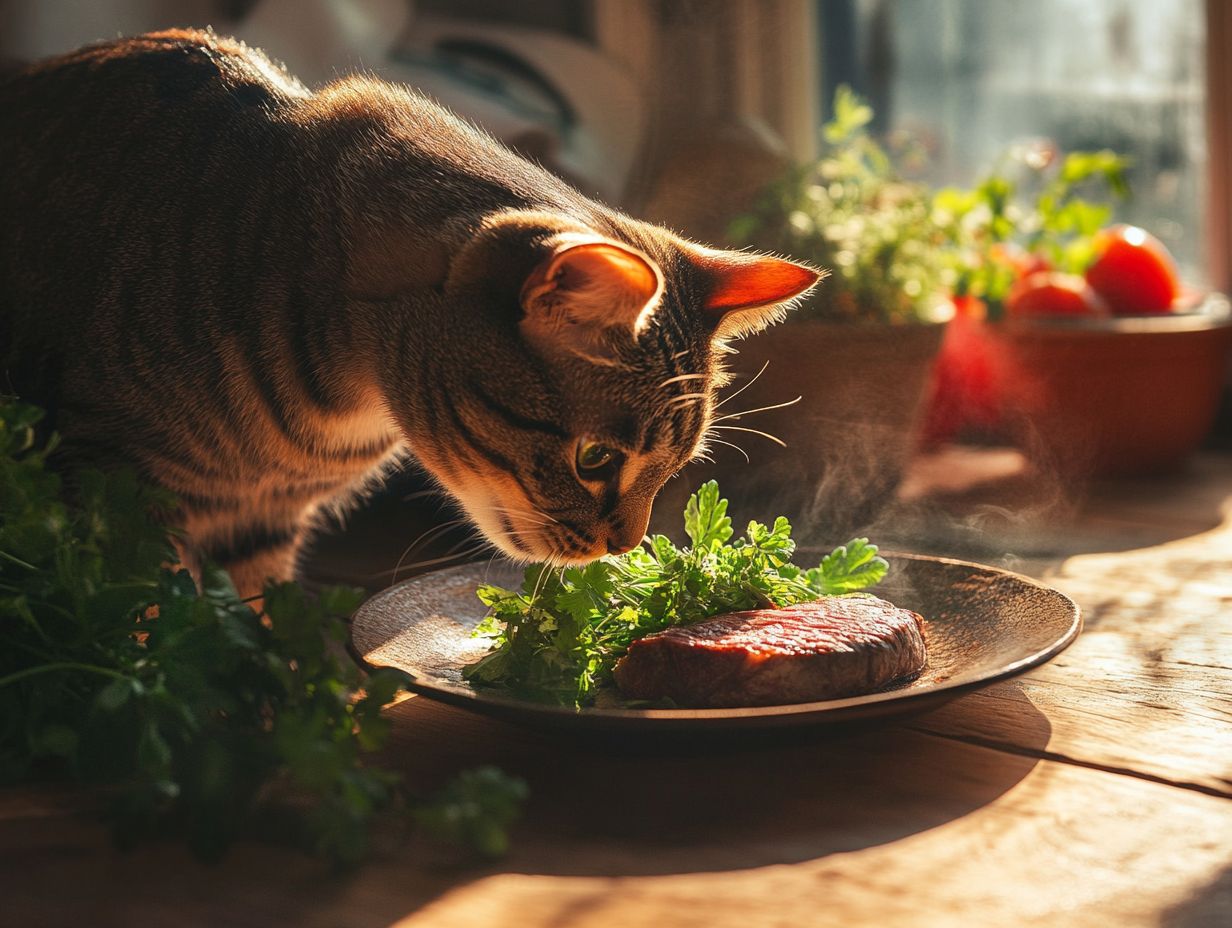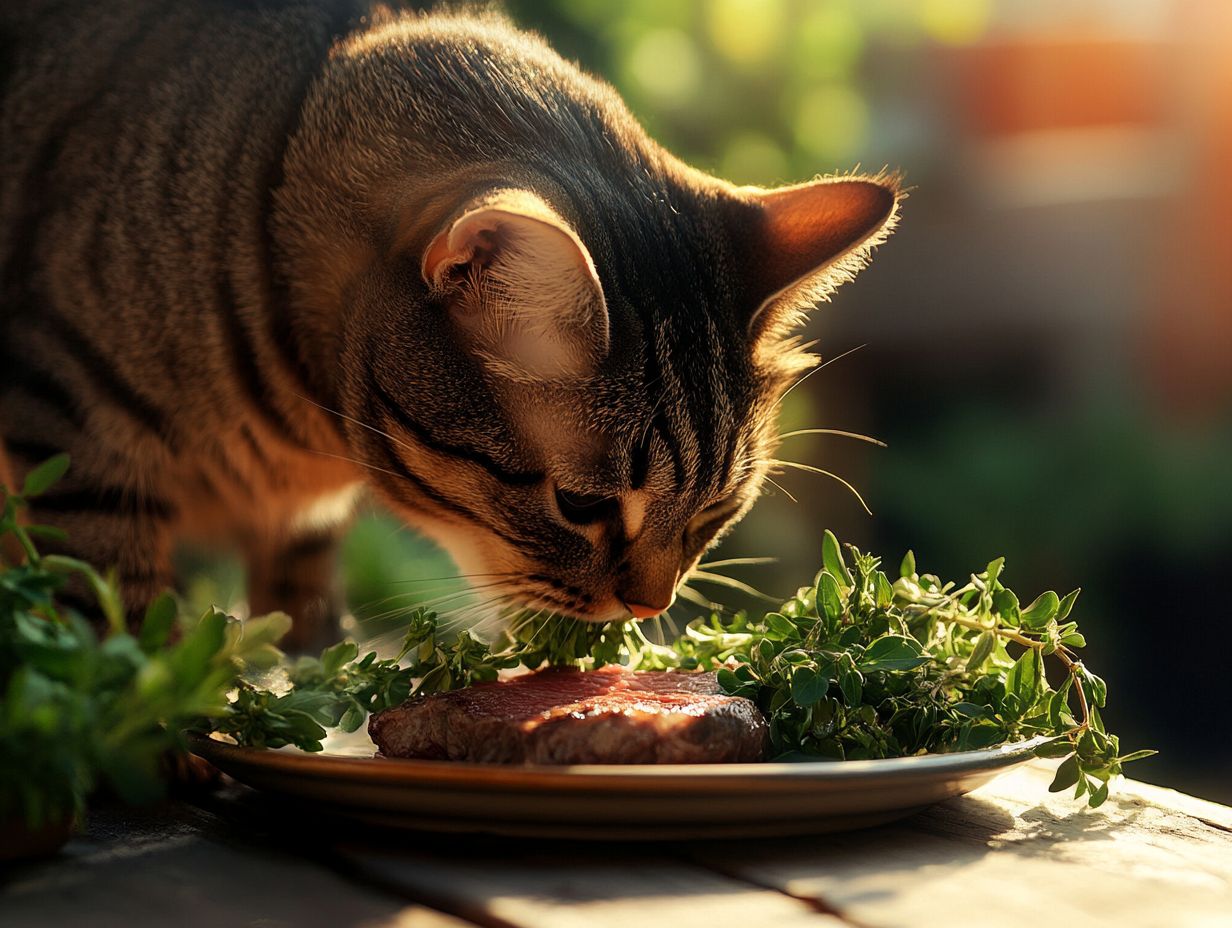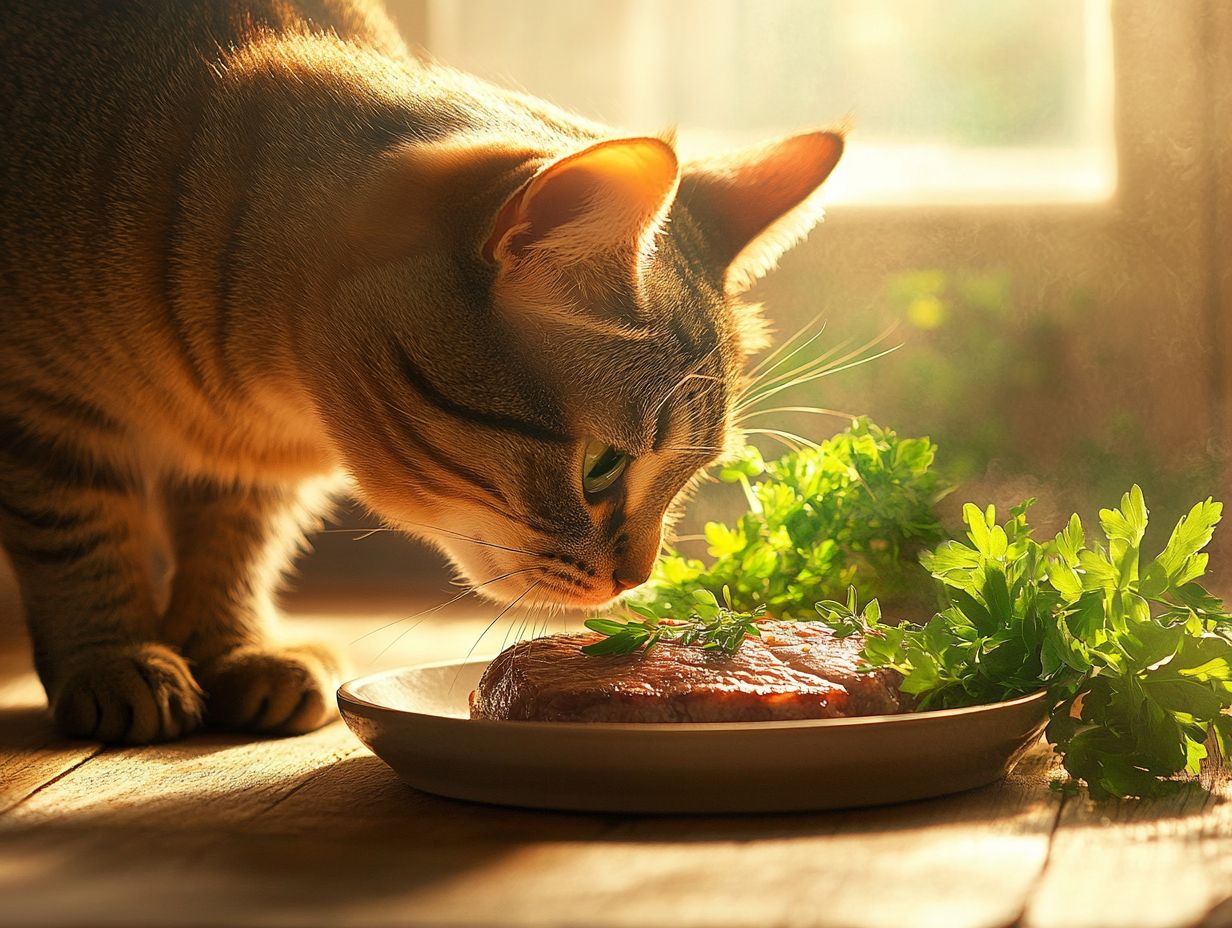Can cats eat steak? Yes, cats can eat steak, but it must be done with caution. Understanding a cat’s diet is essential to keeping them healthy and happy. This guide explores the nuances of feeding steak to your feline friend.
Disclaimer: Always consult with a veterinarian before making any dietary changes for your cat to ensure their health and well-being.
While many pet owners wonder if steak can be a tasty treat for their feline friends, it’s important to explore the nutritional needs and potential risks involved.
This guide covers feeding steak to cats, including:
- Safe preparation tips
- Alternative protein sources
- A comparison of different meats
Let’s find out what’s best for your furry companion!
Key Takeaways:

- Cats have specific nutritional needs and restrictions, making it important to carefully consider their diet before offering them steak.
- While small amounts of steak can provide potential benefits for cats, there are also risks such as choking hazards and digestive issues.
- If you choose to feed your cat steak, it is important to properly prepare and portion the meat (a small piece no larger than 1 ounce) and also consider alternative protein sources for a balanced diet.
- Consult with your veterinarian for personalized advice on safe steak portions for cats.
Understanding a Cat’s Diet
Understanding cats’ diets is essential for making informed decisions about their nutrition and identifying which foods to avoid. As obligate carnivores, cats require a diet that includes a natural balance of proteins, which are crucial for their growth, energy, and overall well-being.1
While safe fruits and vegetables, like watermelon and pumpkin, can be offered as occasional treats, certain foods—such as chocolate, onions, and garlic—must be strictly avoided. Ensuring proper nutrition, including essential vitamins and minerals, is vital in preventing health issues such as obesity and diabetes in our feline companions. Remember to avoid harmful foods like grapes and raisins, which can be toxic.
Nutritional Needs and Restrictions
A cat’s nutritional needs are unique, requiring high levels of protein, specific fats, and very low levels of carbohydrates for optimal health. These feline companions thrive on amino acids found in proteins, such as taurine and arginine, which are crucial for maintaining heart and eye health.2
Offering safe human foods like cooked salmon or tuna can supplement their diet with beneficial omega-3 fatty acids. Healthy fats, including omega-3 and omega-6 fatty acids, are essential for keeping their fur glossy and promoting healthy skin.
It’s important to be mindful of common allergens, such as dairy and grains, which can cause digestive issues. Avoiding dangerous foods like onions, garlic, and chocolate can help prevent serious health problems. Understanding this dietary landscape is critical to ensuring that these pets enjoy long, healthy lives.
Can Cats Eat Steak?
Understanding the benefits and risks of feeding steak to cats can help determine whether it is appropriate for them to consume this food. Consideration of pet insurance and regular vet care can assist in managing any health issues that arise from their dietary choices.
Potential Benefits and Risks

Feeding steak to cats can offer potential benefits, such as providing a nutritious source of protein that supports muscle health and energy. However, it also carries risks, including obesity and insulin spikes, that should not be overlooked. Potential health risks of fatty cuts include pancreatitis and digestive disturbances.3
Steak is rich in high-quality protein and essential vitamins, such as B12, iron, and zinc, which can significantly contribute to a cat’s overall well-being. This protein aids in tissue repair and growth, while B12 supports nerve health and metabolism.
Nonetheless, the high-fat content present in some cuts of steak may lead to excessive calorie intake, increasing the risk of obesity in felines. Weight gain can complicate health issues, elevating the risk of insulin resistance and paving the way for diabetes.4
Therefore, while steak can be a valuable addition to a cat’s diet, it is essential to balance it with other nutrient sources to mitigate potential health concerns. Consider adding safe options like broccoli and avoiding sugar and dairy to maintain their health.
How to Safely Feed Steak to Cats
- Choose lean cuts of steak with low fat content.
- Cook the steak thoroughly without using seasonings.
- Cut the steak into small pieces, no larger than 1 ounce.
- Monitor your cat for any signs of digestive distress after feeding.
- Always provide fresh water alongside any meal.
Conclusion
In summary, feeding steak to cats can be done safely, but it is important to understand the potential benefits and risks. Always prioritize your cat’s health by consulting with a veterinarian and considering their unique dietary needs. Remember, variety in your cat’s diet is just as important as moderation.
In this guide, we will explore the safety, benefits, and risks of feeding steak to cats, along with practical tips for doing so. Safely feeding steak to cats requires proper preparation and portioning to ensure they enjoy the benefits without risking their health.
Preparation and Portioning Tips
When feeding steak to cats, it is essential to avoid any harmful seasonings and to cut the meat into portion sizes that meet their dietary needs. For cats weighing around 10 pounds, a portion can be 1 to 2 ounces of cooked steak as an occasional treat. The steak should be cooked without salt, garlic, or onion, as these ingredients can be toxic to cats.
It is important to cook the meat to an internal temperature of at least 145°F to ensure safety from bacteria like Salmonella and E. coli. Lean cuts of meat are preferred, as they contain less fat and can help prevent obesity in pets.
- Always cook steak thoroughly.
- Avoid seasoning.
- Cut into small pieces to prevent choking.
Portion sizes should be tailored to the cat’s size and activity level; generally, small cats require only a few ounces, while larger cats can have more. Moderation is key to ensuring that cats lead long and healthy lives. For more information, check out Can Cats Eat Steak? A Guide to Safe Feeding.
Alternative Protein Sources for Cats
Exploring alternative protein sources for cats is essential for diversifying their diets and ensuring they receive balanced nutrition from safe, varied options. This can include incorporating cooked eggs or chicken as part of their meals, considering their nutritional profiles and your cat’s specific needs. For example, cooked eggs are a great source of protein, while chicken provides essential amino acids without excessive fat.
Comparing Different Types of Meat

Comparing different types of meat, such as fish, chicken, and beef, reveals their varying nutritional profiles and contributions to a cat’s overall health. Each type of meat has its unique advantages and drawbacks.
For instance, fish is rich in omega-3 fatty acids, which can promote a shiny coat and support cardiovascular health; however, excessive fish consumption may lead to mercury exposure, posing risks over time.5 Chicken serves as a lean protein source that provides essential amino acids necessary for muscle maintenance, yet it can sometimes be higher in fat, which may not suit all feline diets.
Beef, while offering robust protein levels, can also be fatty and may cause digestive issues in some cats. Understanding these nuances allows pet owners to make informed choices about their furry companions’ diets.
Frequently Asked Questions
Can cats eat steak?
Yes, cats can eat steak as part of their diet, but it should not be the main source of food. It should be given as a treat in small amounts.
Is steak safe for cats to eat?
In small amounts, steak is generally safe for cats to eat. However, it should not be a regular part of their diet as it can cause digestive issues and other health problems in excess.
What cuts of steak are safe for cats?

Lean cuts of steak such as sirloin or flank are safe for cats to eat. It’s important to avoid fatty cuts of steak as they can cause pancreatitis in cats.
Can cats eat raw steak?
No, cats should not eat raw steak as it can contain bacteria that can be harmful to their health. It should always be cooked thoroughly before being given to a cat.
How should I prepare steak for my cat?
If you are planning to give your cat steak as a treat, make sure it is cooked well and cut into small, manageable pieces. It’s best to avoid adding any seasonings or spices as they can upset your cat’s stomach.
What are the benefits of feeding my cat steak?
Steak can provide cats with protein and other essential nutrients that are important for their overall health. It can also be a tasty and enjoyable treat for them in moderation.
Always consult with your veterinarian before introducing new foods to your cat’s diet to ensure their health and safety.